“In healthcare, the experience of the patient is the new marketing.”
– David Feinberg, former CEO of Geisinger Health
In Singapore’s fast-paced, tech-forward society, the healthcare system is widely regarded as efficient, modern, and accessible. However, behind this polished exterior lies a growing disconnect between healthcare providers and the patients they serve — a patient experience gap that threatens long-term trust and engagement. Despite digital advancements, many healthcare providers still fall short in understanding the emotional, cultural, and personalized needs of their patients.
At the heart of this gap is a lack of comprehensive patient insight. While hospitals and clinics collect vast amounts of clinical data — such as test results, diagnoses, and prescriptions — they often overlook the softer, qualitative aspects of the patient journey. These include communication preferences, emotional responses, anxieties, and personal health goals. Without this information, providers risk treating conditions rather than people, leading to a transactional experience that leaves patients feeling unheard and undervalued.
Many patients in Singapore report feeling rushed through consultations, with limited time to ask questions or express concerns. This is particularly true in busy public healthcare settings, where high patient volume often comes at the cost of meaningful interaction. For providers, efficiency is key — but for patients, empathy and understanding are equally important. The gap between clinical efficiency and emotional care continues to widen, creating frustration on both sides.
Another major blind spot lies in digital engagement. While Singapore has embraced telemedicine, electronic health records, and mobile health apps, many providers still use these tools primarily for operational convenience rather than to enhance patient experience. For instance, appointment booking apps may be functional, but few offer personalized follow-ups, reminders tailored to the patient’s condition, or options for two-way communication. As a result, technology becomes a passive service tool rather than a channel for building relationships.
Cultural and linguistic sensitivity is also an area where providers often fall short. Singapore’s diverse population — spanning Chinese, Malay, Indian, and various expatriate communities — comes with different health beliefs, languages, and expectations. A one-size-fits-all approach to communication and care often alienates patients, especially the elderly or those less fluent in English. Understanding these nuances requires not just data, but empathy and a willingness to listen.
Bridging this experience gap begins with capturing and acting on the right kind of data. Patient satisfaction surveys, real-time feedback tools, and sentiment analysis can reveal valuable insights into what patients truly care about. Moreover, training healthcare staff in emotional intelligence and cultural competence can dramatically improve patient-provider interactions.
Ultimately, Singapore’s healthcare providers must shift from a systems-centered mindset to a patient-centered one. This means going beyond clinical outcomes and focusing on the entire care journey — before, during, and after treatment. By closing the patient experience gap, providers can build deeper trust, encourage greater health ownership among patients, and deliver care that is not just effective, but truly human.
In a healthcare system known for precision and performance, the next frontier is personalization. And to achieve that, understanding the patient — not just the diagnosis — must become the new standard.


